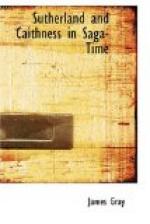Ragnvald Gudrodson, it may here be noted, had, if we pass over his own illegitimacy, in the absence of direct male heirs of Earl Hakon since Erlend Haraldson’s death in 1156, probably the best title to receive a grant of the jarldom of Orkney and Shetland and the earldom of Caithness of all the surviving descendants of Earl Thorfinn Sigurd’s son. For Ragnvald Gudrodson was the grandson of Ingibjorg, Earl Hakon’s elder daughter, while Harold Maddadson was the son of Ingibjorg’s younger sister, Margret of Athole. Ragnvald Gudrodson’s title was, but for his own illegitimacy (in spite of which he held his own kingdom) equal, if not superior to that of all survivors of the Erlend Thorfinnson line, which was now represented in the male line only by another Ragnvald the son of Eric Stagbrellir, who would claim, in default of male heirs of Jarl St. Magnus, through the female line of Erlend Thorfinnson, as being descended successively from Gunnhild, Erlend’s daughter, her son Ragnvald Jarl and Saint, and Ingigerd his only child. And there is no proof that Ragnvald Ericson was alive at this date, or that he ever returned from Norway to prefer his claim.
Ragnvald Gudrodson forthwith collected a great army in Ireland and the Sudreys and invaded Caithness,[42] and, meeting Harold Maddadson in battle at Dalharrold,[43] where the River Naver issues from the loch, drove him northwards down the strath to the coast, whence he escaped to Orkney. The Saga says simply that Harold stayed in Orkney, and this location of the battle near Achness rests solely on tradition, which, however, in the Highlands, is often a solid enough foundation.
King William next conferred the earldom on Ragnvald Gudrodson, for, it is said, a considerable sum of money, reserving his own annual tribute.
On receiving the earldom, Ragnvald Gudrodson left in charge of Caithness six[44] stewards, of whom Lagmann Rafn was the chief, and went back to the Isle of Man. Harold had one of these stewards murdered by an assassin, and returned with a large force to Thurso to punish the Caithness folk; and, when Bishop John interceded for the people of his diocese, Harold, whom he had irritated by refusing to collect the Peter’s Pence which the Earl had given to Rome, would not listen to him, but mutilated him, probably in 1201, nearly blinding him, and all but cutting out his tongue, though afterwards the bishop regained his sight and speech in some measure, and may have lived to administer his diocese till 1213. It is noteworthy that Pope Innocent III, in his letter of 1202, does not directly blame Harold for the illtreatment of the bishop, but Lumberd, a layman, whose penance the letter prescribes.
Harold then drove out the stewards, and they fled to the Scottish king, who made the best amends he could to them,[45] and Rafn, the Lawman, seems to have returned and to have lived and enforced the law in Caithness until at least 1222.[46]




